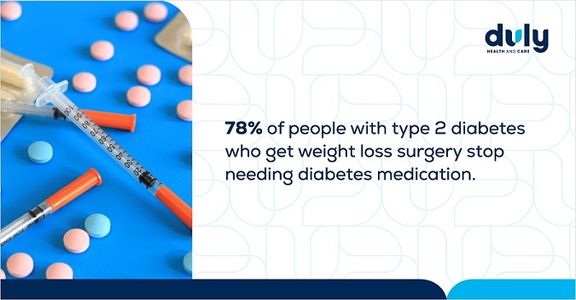Bariatric surgery (also called metabolic or weight loss surgery) is a procedure that helps you lose weight by changing how your digestive system works. It’s usually done after you have tried to lose weight in other ways, like changing your diet and exercise habits. Bariatric surgery can help decrease your risk of serious weight-related problems that can potentially be life-threatening, like heart disease and stroke, high blood pressure, or certain cancers (including breast, prostate, and endometrial).
If you already have type 2 diabetes, bariatric surgery can be a highly effective treatment. Surgery can help reduce diabetes symptoms, decrease blood sugar, and improve your overall health. At Duly Health and Care, our expert surgeons perform laparoscopic and robotic bariatric surgery, offering minimally invasive options with faster recovery and excellent outcomes.
Also read: The Head-to-Toe Benefits of Bariatric Surgery
Here are 6 things to know about type 2 diabetes and bariatric surgery.
1. There Are Several Different Options if You Need Bariatric Surgery.
There are several different types of bariatric surgery, and each one works differently. The two most frequently used in the US are gastric sleeve and gastric bypass.
- Gastric sleeve surgery involves removing about 80% of your stomach to decrease how much food can fit in it and make you feel full sooner.
- Gastric bypass alters your digestive tract so that food avoids (bypasses) most of your stomach and your upper small intestine, reducing how much food you can eat in one sitting and the amount of fat and calories your body can absorb.
Both gastric sleeve and gastric bypass surgeries can be performed using laparoscopic or robotic techniques at Duly Health and Care. Laparoscopic surgeries are minimally invasive procedures that use small cuts rather than large incisions.
There are also methods used less often, such as:
- Biliopancreatic diversion with duodenal switch combines the sleeve and bypass procedures. It affects hormones and metabolism more than the other types. This procedure is often just called a “duodenal switch.”
- Single anastomosis duodenal-ileal bypass with sleeve gastrectomy (SADI‑S) is the most recently approved bariatric surgery. It’s similar to the duodenal switch but is a simpler procedure.
In most cases, bariatric surgery requires a short hospital stay (1 to 2 days) after surgery. However, the adjustable gastric band is an outpatient procedure, meaning you can go home the same day.
2. Certain Types of Bariatric Surgery Are Better for Type 2 Diabetes Than Others.
Some types of bariatric surgery that are not quite as popular in general may be some of the best options for people with type 2 diabetes. For example, the duodenal switch isn’t typically performed as often as the bypass or the sleeve. Despite having the best weight loss results, the duodenal switch has the greatest effect on the hormones that affect hunger, which can make it difficult for people to get the nutrients they need. These procedures not only reduce the size of the stomach or reroute the intestines — they directly change hormone levels, particularly boosting GLP‑1, which helps regulate hunger and glucose.
However, the trade-off can be worth it if you have type 2 diabetes. The hormone changes also improve blood sugar control. Even with the difficulty of getting nutrients, the duodenal switch is considered the most effective bariatric surgery for type 2 diabetes.
If you do decide to go with one of the two main types of bariatric surgery, gastric bypass may be the best option for keeping type 2 diabetes in remission (when your blood sugar is in a non-diabetic range for at least 3 months without being on medication for diabetes). In one study comparing 5‑year outcomes after surgery, 75% of people who had gastric bypass had their diabetes go into remission compared to about 35% of people who got a gastric sleeve. The study also looked at people who regained 100% or more of their weight after surgery. Gastric bypass is often more effective for diabetes remission than gastric sleeve due to its greater hormonal and metabolic impact.
Also read: 5 Diabetes Myths — Debunked
3. Weight Loss Surgery Is a Medical Treatment.
There are a lot of myths about bariatric surgery. One of the most common is that it’s “cheating” and people choose to do it because they don’t want to change their diet or exercise habits. However, this could not be further from the truth.
Bariatric surgery is medical care, no different than surgery for heart disease or cancer. For people with type 2 diabetes who are also obese, bariatric surgery is one of the most effective treatments. In some cases, it can even be more effective than just making lifestyle adjustments or taking medication. It lowers blood sugar, reduces or eliminates the need for medication, and improves diabetes management in almost every case.

4. You Might Not Realize That You’re a Candidate for Bariatric Surgery.
If you always thought that your body mass index (BMI) meant bariatric surgery was out of the question, take a second look.
Your BMI is a measure of your body fat that’s based on your weight and height. A BMI of 30 or greater is considered obese, and a BMI of 40 or more is considered severely obese.
You may have heard that you need a BMI of at least 40 to qualify for bariatric surgery. However, that’s only partially true. Bariatric surgery is also an option if you have:
- A BMI of 35 or more and have a serious obesity-related health problem, like type 2 diabetes, heart disease, or sleep apnea.
- A BMI of 30 or more and type 2 diabetes that is hard to control with lifestyle changes and other medical treatments. This includes patients who may not respond well to GLP‑1 medications like Ozempic or Mounjaro, since surgery triggers your body to produce GLP‑1 naturally and continuously.
A high BMI alone isn’t necessarily enough. You will likely need to take several other steps before getting approved for surgery, such as getting a psychological evaluation, trying other methods of weight loss, quitting smoking, and addressing alcohol or drug addiction.
Also read: Know Your Numbers: How to Calculate Body Mass Index
5. Bariatric Surgery Isn’t a Quick Fix.
Bariatric surgery is a great way to maintain your weight and improve diabetes management, but it’s not a one-and-done solution. It’s best to think of bariatric surgery as a jumping-off point for a healthier future. Although surgery resets your metabolism, your long-term success still depends on consistent nutrition, movement and follow-up care. The changes in hormones like GLP‑1 help reinforce these new behaviors.
After surgery, you will probably need to keep up the liquid diet for a few weeks before gradually reintroducing solid food. You will need to carefully monitor your calorie intake for at least the first year following surgery. That doesn’t mean that after the first year you can start bingeing on chips and ice cream. You will need to follow a diet of small portions full of protein and get plenty of physical activity to keep the weight off.
You will also need to take over-the-counter vitamins and minerals, such as calcium or iron, for the rest of your life.
6. You’ve Got This.
Choosing to have bariatric surgery certainly isn’t easy, and it involves a lifelong commitment to staying healthy. But don’t let that scare you if your provider recommends surgery.
At Duly Health and Care, we combine advanced robotic and laparoscopic surgical techniques with expert support to give you the best possible outcome.
Before you know it, changes like eating enough protein and getting exercise can become second nature. Your healthcare team will always be there to support you before and after surgery. And as you continue to stay at a healthy weight and notice improvements in your diabetes symptoms, you will see that the payoff is worth the effort.
Want to learn more about bariatric surgery? Schedule an appointment with a Duly Health and Care Bariatric Surgeon or call 630−790−1700 for more information.
Health Topics:





